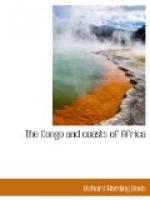In a canoe we were paddled to the back yard of the cafe of Madame Samuel, and from that bower of warm beer and sardine tins trudged through the sun up one side of Banana and down the other. In between the two paths were the bungalows and gardens of forty white men and two white women. Many of the gardens, as was most of Banana, were neglected, untidy, littered with condensed-milk tins. Others, more carefully tended, were laid out in rigid lines. With all tropical nature to draw upon, nothing had been imagined. The most ambitious efforts were designs in whitewashed shells and protruding beer bottles. We could not help remembering the gardens in Japan, of the poorest and the most ignorant coolies. Do I seem to find fault with Banana out of all proportion to its importance? It is because Banana, the Congo’s most advanced post of civilization, is typical of all that lies beyond.
From what I had read of the Congo I expected a broad sweep of muddy, malaria-breeding water, lined by low-lying swamp lands, gloomy, monotonous, depressing.
But on the way to Boma and, later, when I travelled on the Upper Congo, I thought the river more beautiful than any great river I had ever seen. It was full of wonderful surprises. Sometimes it ran between palm-covered banks of yellow sand as low as those of the Mississippi or the Nile; and again, in half an hour, the banks were rock and as heavily wooded as the mountains of Montana, or as white and bold as the cliffs of Dover, or we passed between great hills, covered with what looked like giant oaks, and with their peaks hidden in the clouds. I found it like no other river, because in some one particular it was like them all. Between Banana and Boma the banks first screened us in with the tangled jungle of the tropics, and then opened up great wind-swept plateaux, leading to hills that suggested—of all places—England, and, at that, cultivated England. The contour of the hills, the shape of the trees, the shade of their green contrasted with the green of the grass, were like only the cliffs above Plymouth. One did not look for native kraals and the wild antelope, but for the square, ivy-topped tower of the village church, the loaf-shaped hayricks, slow-moving masses of sheep. But this that looks like a pasture land is only coarse limestone covered with bitter, unnutritious grass, which benefits neither beast nor man.
At sunset we anchored in the current three miles from Boma, and at daybreak we tied up to the iron wharf. As the capital of the government Boma contains the residence and gardens of the governor, who is the personal representative of Leopold, both as a shopkeeper and as a king by divine right. He is a figurehead. The real administrator is M. Vandamme, the Secretaire-General, the ubiquitous, the mysterious, whose name before you leave Southampton is in the air, of whom all men, whether they speak in French or English, speak well. It is from Boma that M. Vandamme sends collectors of rubber, politely labeled inspecteurs, directeurs, judges, capitaines, and sous-lieutenants to their posts, and distributes them over one million square miles.




